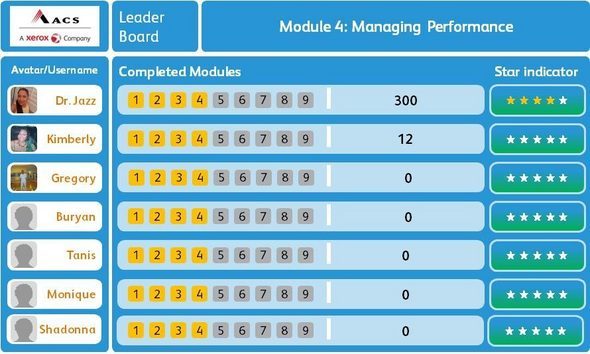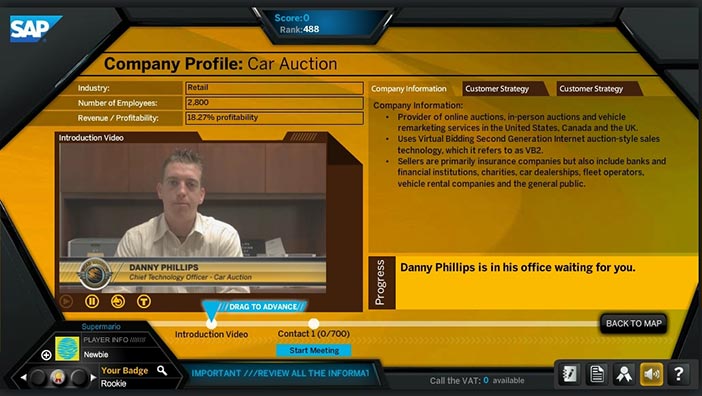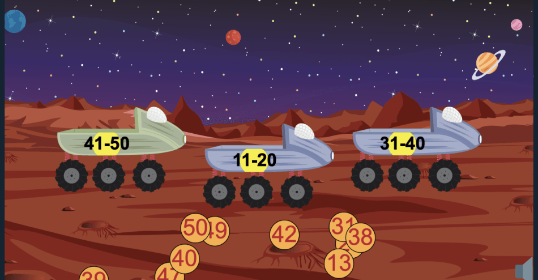Gamification is one of the main trends in corporate eLearning. In this article, our elearning software development company will clarify what it actually is, show its advantages over traditional learning methods, present examples of successfully gamifying corporate training and give evidence-based advice on launching your own gamification program.
How Belitsoft Can Help With Gamification
- Gamification consulting. Insights on how to improve your existing training program or guided creation of a new one with game elements.
- Gamified eLearning apps. Web, desktop, and mobile applications that help your employees or customers learn better.
- Course development. Creating a new course with game elements included.
- Learning games development. Using a game-based learning approach for the benefit of your company.
- Business gamification. Designing a motivation system for non-learning activities.
What is Gamification in Corporate Training?
Gamification is defined as using game-design elements in a non-game situation. This is different from game-based learning where gaming is used to teach players certain knowledge or skills. The line gets blurred in case of learning games, as many of them are just interactive quizzes in disguise.
In corporate environments it is used to increase the learners’ motivation, make training more fun, improve engagement, and, as a result, help the employees train better. While it is not without its risks, gamification has proven its effectiveness and has rightfully been popular in the corporate training centers for the last decade or so.
Peculiarities of Gamification in Corporate Training
There are several aspects that make gamifying corporate learning a bit different. This is directly tied to the principles of adult training and human psychology.
For a gamified training program to be effective, it must:
1. Grant People Autonomy
The program shouldn’t force people to study. Rather it should create an atmosphere that gives learners a feeling of being in charge. When this happens, the motivation soars, and the learning outcomes improve as a result.
On the other hand, if the program feels like a dictator that makes people log in just to avoid punishment, it can actually decrease the employee effectiveness, including the work-related KPIs. Mandatory fun is detrimental.
2. Provide Value
No amount of bells and whistles will make the training program attractive to your employees if this program doesn’t provide something useful. But if the learning can bring meaningful results and bring them fast, people’s trust in it skyrockets.
One of the ways to provide that is having bite-sized learning materials that answer specific work-related questions. Employees can turn to them whenever they need to learn how something is done and use the knowledge they gained right away - both doing their job and improving their skills.
3. Show Competence
The better a person is at a chosen activity, the more they want to go back to it. Gamification should reinforce this aspect by providing fun interactive quizzes, rewards for special achievements and possibly some sort of leaderboard to reinforce the competitive spirit.
Advantages of Gamification over Other Training Methods
Corporate training is the area that the employees are most interested in gamifying.
They have a good reason for it. Gamification has many advantages that put it ahead of other approaches to learning.
1. Increased Motivation and Engagement
A gamified learning environment needs acceptance from the learners themselves to be effective. Fortunately, when there is consent, badges, points, and other similar elements make people spend more time studying voluntarily, whether it is because of perfectionism, competitive spirit or simple fun.
As they are more willing to learn, knowledge retention improves accordingly.
2. Better Learning Habits
With the right design of game elements, you can foster behaviors that make learning more effective. For example, giving badges for revisiting tests can improve knowledge retention by 15-20%. This requires precise planning, but the results are more than worth it.
3. Timely Feedback
This benefit is twofold.
On the one hand, this helps learners understand their strengths and weaknesses, as well as how far along the learning path they have gone. Knowing that they are good at time management (via the “Early bird” achievement”) but not so good at precision (having won no badges for perfectly done tests) will show a user what they need to pay attention to, in order to become better.
On the other hand, gamification features show the employer the problematic areas in their employees’ skills. Moreover, it can function as a supplement or even a replacement for traditional performance reviews, helping promote the best and address issues with the workers who need improvement.
4. Better Engagement
Another advantage of gamification is the feeling of doing meaningful work that learners experience.
There is hardly a need to repeat the fact that happy employees are productive employees and the ones who would stay with the company instead of seeking other job opportunities.
Risks
Note that gamification is a tool, and just like with any other tool it can be misused to a detrimental effect. Just slapping a bunch of badges and a leaderboard onto your learning app can actually make things worse.
One example is the Disneyland Resort Hotels debacle. The company has implemented an electronic leaderboard which showed the performance results for laundry staff. It showed green light for workers who were meeting their production quotas, yellow - for those lagging behind and red for the underperforming. This turned out to be an “electronic whip” forcing people to skip bathroom breaks and punishing pregnant women for not being able to keep up.
Another is the “Slam-Dunk” sales game, which turned out to be only partially successful. “Slam-Dunk” visualized achieving results and making progress (e.g. calling, closing deals, or getting leads) as basketball actions like the eponymous slam-dunk. However, it was only working for the employees who actively consented to its use and endorsed the concept. Those who weren’t on board with the game suffered decreased productivity from “mandatory fun”.
Popular Gamification Features
There are five gamification methods that are used most often.
Points
Each lesson, quiz, and other activity is assigned a certain point value. The more of these the learner completes, the higher his overall rating. While the points themselves may be worth nothing in real life but they are an indicator of the user’s commitment and success.
Leaderboards
People who aren’t very competitive by nature can likely ignore the leaderboards completely. But those who thrive on trying to outdo their fellows, will put in real effort to get to the top.
Some ways to make leaderboards more effective is creating separate ones for different departments and wiping them clean every week so the new learners have a chance to get the first place.
Note that a leaderboard should only be used for positive reinforcement. “Loserboards” are a great way to bring down morale and make everyone hate their job.
Badges
Badges are used to reward specific achievements, like continuously studying 7 days in a row, or completing the course ahead of your peers. They might seem straightforward, but need careful approach to be effective.
For example giving a badge for passing the test perfectly on the first time is deceptive: if the learner makes one mistake, their chance to get the badge is gone forever and it ceases to be a motivating factor.
Levels
The points mentioned above can also be used as experience to help the learner gain “levels” just like a character in a role-playing game. The purpose of this is twofold: firstly, the level can be an indication of the work that the learner put in the training; secondly, it could be used to scale the difficulty of training so that it provides adequate challenge to the user.
Narrative
A human is sometimes defined as a “storytelling animal”, which is an indication of how we all like stories. Using a narrative can give meaning to the actions that the learner takes over the course of the program (e.g. solving a riddle is saving a princess) and thus makes the experience more enjoyable and effective.
Examples of Gamification in Corporate Training
There are many specialty learning areas that can be gamified. Here are some examples.
Onboarding
A good way to make the first impression on your new employees is to give them a fun and engaging way to learn the basics of their new company.
One example of it is Xerox’s Stepping Up application.

The leaderboard in Stepping Up. Source
This is a gamified software that the company uses to train new managers. It allows them to solve “quests” that are based on the real situations they can face in their job. Moreover, some quests can only be solved by a team of people thus improving the users’ teamwork and leadership skills.
Stepping Up is also integrated with Yammer, giving the application a bit of extra social effect.
Employee Engagement
Deloitte Leadership Academy is a resource for training the leadership skills of the executives. The company fully intends to preserve its place among the Big 4 accounting firms, and so has made sure that its management is constantly improving.

Besides the learning materials from top educational institutions like Harvard and Stanford, it features a well-designed gamification system. The leaderboards are especially noteworthy: they are separated by skill levels, departments, and locations, so everyone can compete in their “weight class”. Moreover, the leaderboards are refreshed each week, so that the new hires can have a shot at the first place too.
Compliance Training
Game elements can be used to help people learn about the company code of conduct and official regulations.
For example, Bridgestone, a multinational car parts corporation, holds the “Bridgestone Compliance Battle Royale” for its teams across the world. The participants compete in a series of quizzes via the Kahoot! app. The winners get rewarded with a real trophy and employees with the highest scores get individual gift bags as well.
PriceWaterhouseCoopers, one of the Big 4 auditing companies, has used gamification to approach cybersecurity training. They have developed a “Game of Threats” - an interactive game that helps both coaches and the executives they train to learn about defending from data breaches in a fun and engaging environment.

Game of Threats. Source
The players are divided into teams called “Threat Actor” and “Company”. Each team has a number of cards they can play - such as “DDOS Attack” for the hackers and “Network Scans” for the defenders. The players decide which actions they should take to win, while the trainers give advice and provide feedback.
Skill Training
SAP, a large business software corporation, uses a game called “Road Warrior” to train its sales reps.

SAP Road Warrior. Source
This is actually an interactive quiz disguised as a “Who Wants to Be a Millionaire?”-style game. It simulates a “pre-call” session with a customer and rewards players for making choices that bring them closer to closing a deal. As a salesperson progresses through the game they can level up and gain badges to show off their skills.
Advice on Gamifying Corporate Learning
According to the Scientific American magazine, there are three main elements in any motivational program, including gamification of corporate eLearning:
- Autonomy. When people have a feeling of control they tend to be more determined in reaching their goals.
- Value. If people feel that they are learning something useful, they are more motivated.
- Competence. The better a person becomes at something, the more enjoyment this activity brings.
Best practices in gamification are based on these elements.
Clear Goals
While improving the mood of your employees is a noble endeavor, to achieve success you need a specific and measurable business goal. It could be improved knowledge retention rate, increased sales, shorter meeting times, etc. - anything that directly affects employee productivity and the company’s bottom line.
Your learners should have clear goals too. Knowing that they will be rewarded for successful completion of a quiz without mistakes shows them which behavior is beneficial for them and, in turn, to the company.
Carrot, not Stick
The example of Disneyland shows that gamification elements are beneficial only if used as positive reinforcement. Otherwise, they would be just as effective in driving people away from the eLearning program and demotivating them.
Appropriate Challenge
What is the point of an achievement badge if anyone can get it with little to no effort? Gamification elements should give learners a challenge that fits their skill level. Too much or too little, and it risks becoming either boring or demotivating. This is the reason companies reset their leaderboards, for example: otherwise, some employees will hoard the top spots making it impossible for others to reach and forcing one group to rest on their laurels and another to give up on the competition whatsoever.
Varying Incentives
Depending on the nature of people’s work, they will be motivated by different things. So it is vital to design your corporate learning gamification program in a way that incentivizes its target audience specifically. For example, engineers developing a device and salespeople promoting it will be driven by different things.
Rate this article
Recommended posts
Portfolio

Our Clients' Feedback


















.jpg)
.jpg)
![Artificial Intelligence in Education [Ultimate Knowledge Hub]](/uploads/images/blog/posts/previews/image_163177848252-image(600x250-crop).jpg)
.jpg)
.jpg)
.jpg)
.jpg)
.jpg)
.jpg)
.jpg)
.jpg)
![How to Create a Language Learning App [The Ultimate Guide!]](/uploads/images/blog/posts/previews/image_155352483594-image(600x250-crop).png)
.jpg)
.jpg)
.jpg)
.jpg)
![Integrate Your CRM with LMS to Increase Sales [Start now!]](/uploads/images/blog/posts/previews/image_162030700147-image(600x250-crop).jpg)
.jpg)
.jpg)
.jpg)
.jpg)
.jpg)
.png)
.jpg)
.jpg)
.jpg)
.png)
.jpg)
.jpg)
.jpg)
.jpg)
.jpg)
.jpg)
.jpg)
.jpg)
.jpg)
.jpg)
.jpg)
.jpg)
.jpg)
.jpg)
.jpg)
.jpg)
.jpg)
.jpg)
.jpg)
.jpg)
.jpg)
.jpg)
.jpg)
.jpg)
.jpg)
.jpg)
.jpg)
.jpg)
.png)
.png)
.png)


















We have been working for over 10 years and they have become our long-term technology partner. Any software development, programming, or design needs we have had, Belitsoft company has always been able to handle this for us.
Founder from ZensAI (Microsoft)/ formerly Elearningforce